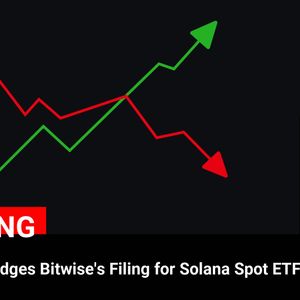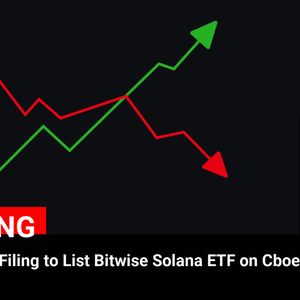Just when the buzz around spot Ethereum ETFs was reaching a fever pitch, a surprising turn of events has caught the crypto community’s attention. On February 10th, U.S. spot Ethereum ETFs collectively experienced a total net outflow of $22.46 million. This unexpected shift, initially reported by Trader T on X, raises questions and sparks discussions about the immediate future of these investment vehicles and the broader Ethereum market. Let’s delve into the details of this development and understand what’s behind these Ethereum ETF outflows . Spot Ethereum ETFs: What’s the Buzz About? Before we dissect the outflow specifics, it’s crucial to understand what spot Ethereum ETFs are and why they’ve become a hot topic in the crypto space. In essence, a spot Ethereum ETF is an exchange-traded fund that directly holds Ether (ETH). This allows investors to gain exposure to the price movements of Ethereum without directly owning the cryptocurrency itself. Think of it as investing in gold through a gold ETF, but for Ethereum. The appeal of spot Ethereum ETFs is multifaceted: Accessibility: ETFs are easily accessible through traditional brokerage accounts, making Ethereum investment available to a wider range of investors, including institutional players who might be restricted from directly holding crypto. Regulation and Security: ETFs operate within regulated frameworks, offering a layer of security and investor protection that might be lacking in direct crypto ownership. Simplified Investment: For those daunted by the complexities of crypto wallets, private keys, and exchanges, ETFs provide a simplified and familiar investment route. With the successful launch of spot Bitcoin ETFs in the U.S., anticipation for similar Ethereum products has been immense. The expectation was that spot Ethereum ETFs would follow a similar trajectory, attracting significant inflows and boosting Ethereum’s market presence. However, the recent outflow data presents a contrasting narrative, at least for February 10th. Unpacking the $22.46 Million Ethereum ETF Outflows Now, let’s break down the specifics of the reported Ethereum ETF outflows . According to Trader T’s data, the entire $22.46 million net outflow originated solely from Grayscale’s Ethereum Trust (ETHE). Interestingly, all other U.S. spot Ethereum ETFs registered no net changes – neither inflows nor outflows – on the same day. To visualize this more clearly, consider the following: Ethereum ETF Net Flow (Feb 10) Notes Grayscale ETHE -$22.46 Million Sole contributor to total net outflow Other Spot Ethereum ETFs (Combined) $0 No net change in inflows or outflows Total Net Outflow (All Spot Ethereum ETFs) -$22.46 Million Reflects only Grayscale ETHE outflows This table highlights a crucial point: the negative flow wasn’t a widespread trend across all spot Ethereum ETFs , but rather concentrated within Grayscale’s ETHE. This immediately prompts the question: Why Grayscale ETHE specifically? Why is Grayscale ETHE Seeing Outflows? Examining ETHE Outflows To understand the ETHE outflows , we need to consider Grayscale’s unique position in the ETF landscape. Grayscale’s ETHE initially existed as a private trust before converting to a spot ETF. This conversion, while a positive step for accessibility, also unlocked shares that were previously locked up, potentially leading to profit-taking by investors who had held these shares for a considerable period. Several factors could be contributing to the ETHE outflows : Profit Taking: Investors who bought into ETHE at lower prices before its ETF conversion might be taking profits after the price appreciation following the ETF launch and broader market recovery. Fee Structure: Grayscale’s ETHE has a relatively higher management fee compared to some of its competitors. Investors might be shifting to lower-fee options now that spot Ethereum ETFs are available from multiple issuers. Market Rotation: It’s possible that investors are reallocating capital within the crypto space, moving funds from ETHE to other assets or investment vehicles, perhaps in anticipation of other market opportunities. General Market Sentiment: While Ethereum has shown resilience, broader market uncertainties or profit-taking across crypto assets could also be influencing outflows from ETHE. It’s important to note that a single day’s outflow doesn’t necessarily indicate a long-term trend. Market fluctuations are common, especially in the volatile crypto sector. However, sustained outflows from ETHE could signal underlying investor sentiment towards this particular product or broader concerns about the Ethereum ETF market . Impact on the Ethereum ETF Market and Beyond While the $22.46 million outflow is isolated to a single day and primarily to Grayscale’s ETHE, it’s still a development worth monitoring. The Ethereum ETF market is still in its early stages, and any significant fund movements can be interpreted as indicators of investor confidence and market maturity. Here’s how these outflows could impact the broader ecosystem: Short-Term Price Pressure: Outflows, if sustained, could exert some downward pressure on Ethereum’s price, although the overall market impact of a single day’s outflow is likely to be limited. Competitive Landscape: The outflows from ETHE could benefit competing spot Ethereum ETFs if investors are indeed switching to lower-fee or preferred options. This could intensify competition within the ETF market and potentially lead to fee adjustments or product innovations. Investor Sentiment Check: This event serves as a reminder that the crypto ETF market, while promising, is not immune to volatility and shifts in investor sentiment. It underscores the importance of diversification and careful consideration of investment choices. Market Maturation: Ultimately, events like these are part of the maturation process of the Ethereum ETF market . They provide valuable data points for issuers, investors, and market analysts to understand the dynamics of this evolving asset class. Navigating the Ethereum ETF Landscape: Key Takeaways So, what are the actionable insights from this unexpected outflow event? Don’t Panic: A single day’s outflow, especially concentrated in one ETF, shouldn’t be interpreted as a catastrophic event. The Ethereum ETF market is still nascent and prone to initial fluctuations. Monitor Trends, Not Just Headlines: Pay attention to sustained trends in ETF flows over weeks and months, rather than reacting to isolated daily figures. Understand ETF Specifics: Different ETFs have different fee structures, holdings, and historical performance. Conduct thorough research before investing and understand the nuances of each product. Diversify Your Portfolio: As always, diversification remains a key principle in crypto investing. Don’t put all your eggs in one basket, whether it’s a single ETF or any other asset. Stay Informed: The crypto market is dynamic. Keep yourself updated on market news, ETF developments, and broader macroeconomic factors that could influence your investments. In conclusion, the $22.46 million outflow from U.S. spot Ethereum ETFs on February 10th, driven entirely by Grayscale’s ETHE, is a noteworthy event that warrants attention. While it might trigger short-term concerns, it’s crucial to analyze this development within the broader context of the evolving Ethereum ETF market . The crypto ETF space is still young, and such fluctuations are expected as the market finds its footing. For investors, the key is to remain informed, exercise caution, and maintain a long-term perspective. To learn more about the latest crypto market trends, explore our article on key developments shaping Ethereum price action.




















